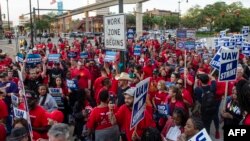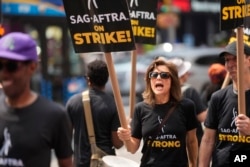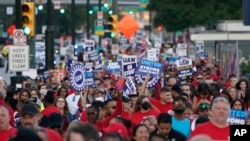The announcement last week that the United Auto Workers (UAW) union would go on strike against the country’s three largest car manufacturers put an exclamation point on what has been one of the most active years for the labor movement in recent U.S. history.
The UAW strike against Ford, General Motors and Stellantis began on Friday with targeted walkouts in just a handful of plants. But the strike could grow to include most or all of the union’s 146,000 members. They would join tens of thousands of members of the Writers Guild of America (WGA) and the Screen Actors Guild-American Federation of Television and Radio Artists (SAG-AFTRA), whose combined strike has caused most movie and television production to grind to a halt.
While the strikes by the UAW and the actors and writers guilds have attracted the most media attention, they are far from alone in deciding to use labor actions to demand higher pay or better working conditions this year.
Over the summer, drivers for shipping giant United Parcel Service (UPS) used threats of a Teamsters Union strike to negotiate a more favorable contract. Throughout the year, Starbucks has endured a series of targeted job actions at many of its ubiquitous coffee shops, while a movement to organize workers at warehouses run by delivery behemoth Amazon has gained traction.
Turning point
Strikes and other job actions by labor unions in the United States are far less frequent than they were a generation ago, largely as the result of a decadeslong campaign to pass laws that limited unions’ ability to organize and strengthened the hand of management in negotiations. But in 2023, unions have been enjoying a resurgence.
“There’s a lot more going on in the past year than we've seen in a very long time, in terms of both union organizing successes, as well as either strikes or threatened strikes,” said Susan J. Schurman, distinguished professor of labor studies and employment relations at Rutgers University.
“The labor market remains relatively tight, and when that's true, workers gain leverage in relation to the employer,” she told VOA. “This is the first time in decades that we've had this circumstance, and unions are taking advantage of it both to organize as well as to try to make gains in collective bargaining.”
They have also found a receptive audience among U.S. workers.
According to Schurman, “American workers have been angry for a long time, because average wages have been stagnant for decades.” She said a combination of small but significant organizing successes at companies long resistant to unionization, as well as the high visibility of strikers in Hollywood, have combined to raise the labor movement’s profile, particularly among younger workers.
Hollywood strike
The WGA went on strike in May and was joined by SAG-AFTRA in July. Both unions are demanding that the movie and television studios that employ them update contracts to reflect the changing dynamics of the business, including the new dominance of streaming video, and the multiple threats that generative artificial intelligence poses to those in the creative professions.
Progress in negotiations has been glacial. Negotiations between the Alliance of Motion Picture and Television Producers and the WGA broke down over the summer but were scheduled to resume this week.
Negotiations in the SAG-AFTRA strike, though, have been discontinued, with no resumption in sight. Meanwhile, the union’s strike activity looks likely to expand. Union president Fran Drescher has signaled that the union may soon target the video gaming industry, which relies on SAG-AFTRA members for voice-overs and motion capture work.
‘Trench warfare’
“They're progressing very, very slowly, if at all,” Jonathan Handel, a media attorney and journalist, told VOA. “The Writers Guild negotiations have been trench warfare, frankly. Every inch of movement by either side is gained at enormous cost and time, and enormous cost in suffering for those who are out of work.”
Handel, author of “Hollywood on Strike!: An Industry at War in the Internet Age,” which tells the history of the 2007 actors strike, said the latest strikes may well continue into next year.
“I think a window is very definitely closing to get deals done this year,” he said. “If you don't see deals with both unions done in the next four or five weeks, then we hit the holiday period, and you won't see deals until sometime next year.”
Should that happen, he said, the pressure on the studios will mount, because the industry’s contracts with the Teamsters and the International Alliance of Theatrical Stage Employees, which represents much of the industry’s behind-the-scenes workforce, come up for renegotiation.
UAW strike
The UAW strike began Friday with walkouts at three factories, one each owned by Ford, General Motors and Stellantis. So far, only about 13,000 of the union’s 146,000 members have walked off the job. However, UAW president Shawn Fain has made it clear that the possibility of a broader work stoppage is clearly on the table.
Officials at the company have said that because the components made at the striking factories are essential for operations at other facilities, they may soon begin laying off workers who are not actively striking.
The union is actively talking with the automakers, but the negotiations have a different feel than they did in the past, when much of the discussion happened in private. A corruption scandal at UAW in 2020 led to a shake-up not just in the union’s leadership, but in how that leadership is chosen.
In 2020, an investigation by the Department of Justice led to the conviction of 12 UAW officials and three executives of Fiat Chrysler (a predecessor of Stellantis) on a collection of charges including racketeering, tax evasion and embezzlement. The case involved more than $15 million in improper charges to UAW-funded worker training programs.
"What's unprecedented is the way negotiations are unfolding,” said Jeff Gilbert, Detroit automotive reporter for WWJ Newsradio. “They used to be behind closed doors. You wouldn't learn anything. Now, the union president lays out what they want, the car companies lay out some of their offers, the union president gets mad and throws those offers in the trash, and there is a little bit of theater there.”
“They are much more out in public, and that's because you have a different UAW after the corruption scandal,” Gilbert told VOA. “They started directly electing presidents, and Shawn Fain ran on a platform of being tougher with the car companies, so he is basically rewriting the playbook.”












